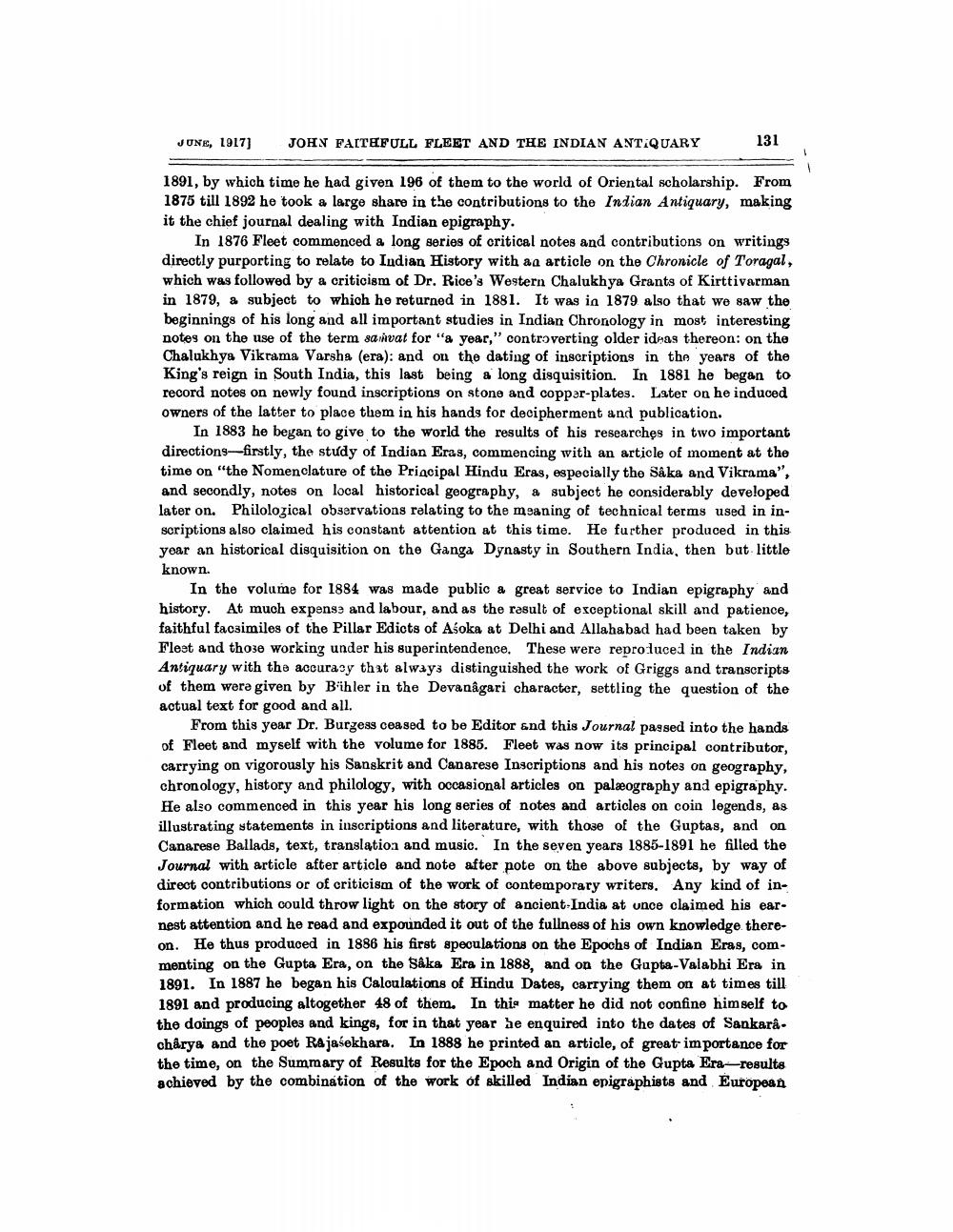________________
JUNE, 1917)
JOHN FAITHFULL FLEET AND THE INDIAN ANTIQUARY
131
1891, by which time he had given 196 of them to the world of Oriental scholarship. From 1875 till 1892 he took a large share in the contributions to the Indian Antiquary, making it the chief journal dealing with Indian epigraphy.
In 1876 Fleet commenced a long series of critical notes and contributions on writings directly purporting to relate to Indian History with an article on the Chronicle of Toragal, which was followed by a criticism of Dr. Rice's Western Chalukhya Grants of Kirttivarman in 1879, & subject to which he returned in 1881. It was in 1879 also that we saw the beginnings of his long and all important studies in Indian Chronology in most interesting notes on the use of the term sa invat for a year," controverting older ideas thereon: on the Chalukhya Vikrama Varsha (era): and on the dating of inscriptions in the years of the King's reign in South India, this last being a long disquisition. In 1881 he began to record notes on newly found inscriptions on stone and copper-plates. Later on he induced owners of the latter to place them in his hands for decipherment and publication.
In 1883 he began to give to the world the results of his researches in two important directions-firstly, the stưdy of Indian Eras, commencing with an article of moment at the time on "the Nomenclature of the Priacipal Hindu Eras, especially the Såka and Vikrama", and secondly, notes on local historical geography, a subject he considerably developed later on. Philological observations relating to the meaning of technical terms used in inscriptions also claimed his constant attention at this time. He further produced in this year an historical disquisition on the Ganga Dynasty in Southern India, then but little known.
In the volume for 1884 was made public a great service to Indian epigraphy and history. At much expense and labour, and as the result of exceptional skill and patience, faithful facsimiles of the Pillar Edicts of Asoka at Delhi and Allahabad had been taken by Fleet and those working under his superintendence. These were repro luced in the Indian Antiquary with the accurasy that always distinguished the work of Griggs and transcripts of them were given by B'ihler in the Devanagari character, settling the question of the actual text for good and all.
From this year Dr. Burgess ceased to be Editor and this Journal passed into the hands of Fleet and myself with the volume for 1885. Fleet was now its principal contributor, carrying on vigorously his Sanskrit and Canarese Inscriptions and his notes on geography, chronology, history and philology, with occasional articles on palæography and epigraphy. He also commenced in this year his long series of notes and articles on coin legends, as illustrating statements in inscriptions and literature, with those of the Guptas, and on Canarese Ballads, text, translation and music. In the seven years 1885-1891 he filled the Journal with article after article and note after pote on the above subjects, by way of direct contributions or of criticism of the work of contemporary writers. Any kind of information which could throw light on the story of ancient-India at once claimed his earnest attention and he read and expounded it out of the fullness of his own knowledge thereon. He thus produced in 1886 his first speculations on the Epochs of Indian Eras, commenting on the Gupta Era, on the Såka Era in 1888, and on the Gupta-Valabhi Era in 1891. In 1887 he began his Caloulations of Hindu Dates, carrying them on at times till 1891 and producing altogether 48 of them. In this matter he did not confine himself to the doings of peoples and kings, for in that year he enquired into the dates of Sankara. charya and the poet Rajasekhara. In 1888 he printed an article, of great importance for the time, on the Summary of Results for the Epoch and Origin of the Gupta Era-results achieved by the combination of the work of skilled Indian epigraphists and European




